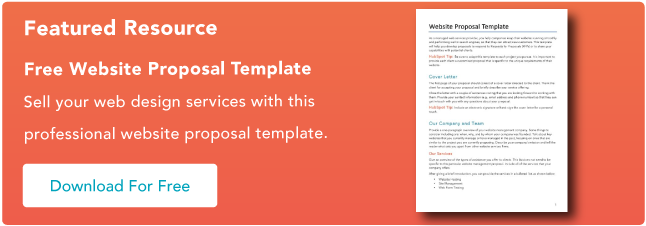Web design services are a big investment. As a client, you don’t want to just throw your money at someone who sends a proposal that leaves you scratching your head.

I've been there. Redesigning a website for a charitable fund felt overwhelming. At times, the design team would throw technical questions without understanding the business model, making the challenge even more difficult.
The results? Most web pages were initially okay, but a few fell apart. That’s a little disappointing when the initial website design proposal promised everything under the sun.
In this article, I explain a website design proposal, what to include, and best practices for perfecting your document. Setting the right expectations saves you time and saves your clients headaches. Let’s dive in!
Table of Contents- What is a website design proposal?
- What to Include in a Website Design Proposal
- Website Proposal Template
- Website Redesign Proposal
- Tips and Best Practices: How to Write a Website Design Proposal
What is a website design proposal?
Simply put, your website design proposal is a document, a slide deck, or maybe a PDF that is a summary of everything you hope your web design project will accomplish for your client. Project managers and clients will review this document.

Your website design proposal is not the final business agreement between the two parties. However, this document may act as a benchmark for the project.
If you’re freelancing as a web designer or working in a web design agency, having a pre-made web design proposal template can help streamline your onboarding process with new clients. You can then easily convey the goals and timeline of the project.
What to Include in a Website Design Proposal
Creating a web design proposal template can help streamline your onboarding process. You might find that you need to add or remove sections from your web design proposal template. However, you should consider including the following components as a starting point.
Overview
Think of this section as your first impression. You can use this lightweight page to communicate to your client that you have taken their information and are ready to work for them professionally. Consider including:
- The client’s business name.
- The client’s point of contact.
- Your business.
- Your contact information.
- Project name.
- The date when the proposal was submitted.
Again, this document does not act in any legal way between you and the client. However, all this information can help both parties stay on the same page.
There’s also a good tip from Phil Storey, founder of Glow. He says, “Include a Care Plans section in your website proposals. I‘ve managed 500+ WordPress sites. That figure would be microscopic in comparison if I’d left the support and maintenance convo until after I'd built the site.”
Goals
A project goal is what the client hopes the project will accomplish. Likely, the project exists because a problem has arisen for your client. Your goal should solve that problem, whatever it may be. In this section, you can include the following.
The client’s problem, for example, could be:- The client’s current website is not attracting new visitors at the rate needed for business development.
- The client’s current website is built on outdated software.
- The client’s website feels out of step with their current brand, creative, or content strategy.
- The client wants to increase leads from her website by 20%.
- The client wants to learn how to maintain the website herself.
- The client wants to upgrade brand imagery to be standard across all platforms.
- The client wants to hire more employees.
- The client wants to drive down overhead to reduce freelancers.
- The client wants to communicate their brand story across platforms.
Here’s what Kyle Prinsloo suggests in one of his amazing YouTube tutorials:
“The key is to use the same language your client uses when they talk about the goal and the problems they need to solve. It‘s important that you don’t use jargon that the client won't understand.”
Solution
The solution describes how you’ll reach the project‘s goals and/or solve the problem. If the project’s goal is the final destination, then the solution is the route you’ve mapped out to take you from here to there.
But, before jumping to the solution, make sure you have everything crystal clear to avoid wasting time on endless revisions. Here's what graphic designer Gloria Condy advises.
“I want to clarify and make sure I have a right or maybe there are gaps in information that I need to hear from them. It‘s important to actually really listen to what the client has to say so you can ask more questions and get a better understanding of what their visions are. Don’t leave any stone unturned—if you have anything that you are unsure about, ask them,” Condy says in a YouTube video.
In the solution, you’ll want to be very detailed about the processes, tools, and time needed to get there. That includes:
- Steps. Utilize this section to outline the steps you will need to execute this solution. Will you be writing copy? Will you be designing assets? Will you be setting up a server or a newsletter platform?
- Tools. Take a moment to list out what tools you will use to get the job done. This might be a HubSpot account with hosting, a WordPress theme, or an Adobe Creative Cloud account.
- Resources. Resources might include any partners you require help from along the way. If you’re working with an agency, this could involve your coworkers who are SEO specialists, copywriters, and marketers. On the client side, this could include product designers or UX folks. Consider anyone whose time might be impacted by the project.
- Time. Detail the time you think it will take to complete the project. Consider all parts of the project, from the time of your proposal to the finish line, plus any upkeep.
Schedule
It’s a good idea to be upfront about the workflow, and the schedule allows you to get concrete about the steps you outlined in the previous section. For instance, if you’re creating a website for a client, your schedule might look like the following.
|
Step |
Time |
Workflow |
|
SEO research |
1 Day |
Agency (you/your team) |
|
Brand name research |
1 Day |
Agency |
|
Brand name approval |
1 Day |
Client |
|
Buy domain name |
1 Day |
Agency |
|
Create WordPress hosting account |
.5 Days |
Client |
|
Outline site architecture |
1 Day |
Agency |
|
Site architecture approval |
1-3 Days |
Client |
|
Outline landing pages content |
1 Day |
Agency |
|
Landing page content approval |
1-3 Days |
Client |
|
Web content copywriting |
2-5 Days |
Agency |
|
Web content editing |
1-3 Days |
Client |
|
Client photoshoot |
5-7 Days |
Agency + Client |
|
Web content production |
5-7 Days |
Agency |
|
Web content production QA + testing |
5-7 Days |
Agency + Client |
You can also include deadlines or a project plan, such as a waterfall diagram, to show how the workflow impacts each team.
Quote
Working with your business manager and the client’s budget in mind, calculate the hours of work involved based on your rates. Then, provide the client with a detailed quote so they can determine whether or not it aligns with their ROI.
Your quote should include all work involved on your or your agency’s side.
|
Project/Service |
Time |
Quote |
|
Domain setup |
2 hours @ $65/hr |
$130 |
|
WordPress development |
24 hours @ $65/hr |
$1,560 |
|
Content production — five pages and three landing pages |
8 hours @ $35/hr |
$280 |
|
Content production — on-page SEO strategy |
8 hours @ $35/hr |
$280 |
|
Total |
$2,250 |
If your client is working with other photographers, designers, or writers, only include what work you or your agency will do for this project. You may need to add a little overhead to your hourly rate to make your own ROI worth it. That is perfectly acceptable.
You have costs to consider, beyond time, including:
- Office space rent.
- Hiring partners or subcontractors.
- Electricity bills.
- Internet bills.
- Adobe subscription service.
- And more.
Your quotes to your clients should help you cover all of these costs within reason.
.png)
Free Website Design Inspiration Guide
77 Brilliant Examples of Homepages, Blogs & Landing Pages to Inspire You
- Agency Pages
- Ecommerce Pages
- Tech Company Pages
- And More!
Download Free
All fields are required.
.png)
Kyle Prinsloo, founder of ClientManager, suggests that teams always offer three pricing options. Why, you might ask?
“For one thing, a proposal is an opportunity to upsell your services, but there's also an important psychological aspect at play. Most people like choices, but not too many choices. Marketing experiments have shown time and time again that three is the magic number when it comes to pricing tiers,” Prinsloo says.
Terms
Your terms include how and when you want to be paid, as well as how and when you will deliver the work to your client.
Typical terms for freelancers are what are called “net15” or “net30.” Smaller projects can be paid out 15 days after completion, while larger projects may need 30 days after completion for total remittance.
You will probably already be set up to send invoices to clients ahead of sending them a proposal, but if this is your first time, you can use HubSpot’s invoice template generator.
Call-to-Action
At the end of the day, the web design proposal must sway the client to do business with you. That’s why some designers and agencies include a CTA with their proposals. For instance, you might include:
- A link to an e-sign document to start the work.
- A link to pay the down payment on the project.
- A link to a menu of other goods or services that you offer.
Coverage
At the start of any project, include all coverage and points of contact. Especially if this is a new client, they might not know that you won’t be handling the design yourself or that you farm out photography.
If you want them to be able to reach any partners that you work with, include the information here. Likewise, if you plan to be out of the office during the project schedule, include any backup contacts to reference in your absence.
Contact Information
Include your direct line of contact as well as the billing address for your freelance business or agency. Don’t assume the client knows what it is!
Pro tip: Don't waste time scouring the internet for your web design needs. Instead, head over to HubSpot Hub for an array of web design tools. From website graders to A/B testing kits to Python training, you'll find everything you need housed under one roof.
Website Proposal Template
I‘ve put together a handy template to speed up the proposal process that responds to RFPs (a request for proposals). Let’s see what’s inside and how to fill it out. I’ll use the example of crafting a website for Charmaloo, a brand specializing in custom-designed mockup clothing.

Cover Letter
What it includes:
- A brief introduction to your proposal.
- A thank-you note to the client for considering your proposal.
- A summary of your service offerings.
- Contact information for follow-up questions.
How to fill it out:
- Start with a formal greeting and thank the client.
- Introduce your company and summarize the key services you offer.
- Show enthusiasm about the potential collaboration (don’t overdo it).
- Include your contact details (email, phone number, and/or SM accounts).
- Sign off with a professional closing, and include an electronic or handwritten signature for a personal touch.
Example:
Let’s now see how I crafted the cover letter for the Charmaloo brand on behalf of Your Web Solutions (a fictional web services site).
Dear Charmaloo team,
Thank you for considering Your Web Solutions for your website management needs. We are excited to show how our services can bring your mockup promotion vision to life, help your website perform optimally, and attract new customers.
Looking forward to the opportunity to work with you.
Best regards,
John Smith
Your Web Solutions
Email: info@yourwebsolutions.com
Phone: (555) 123-4567
Our Company and Team
What it includes:
- An overview of your company.
- Key information about your founding, mission, and unique qualities.
- Highlights of similar projects you have managed.
How to fill it out:
- Provide a brief history of your company—its founding date and mission.
- Mention any notable projects or clients, especially those similar to the prospective client's industry.
- Show what sets your company apart from competitors.
Example
In this part, I wanted the introduction to sound simple, interesting, and, most importantly, focused on creative/similar businesses to show our experience in this field.
Your Web Solutions was founded in 2010 with a mission to provide only the best web management services. We have successfully managed websites for various clients, including fashion retailers, art galleries, and creative agencies.
Our notable projects include the website design for XYZ Apparel, where we increased online sales by 30% within six months of launch. Our experience in the fashion and creative industries uniquely positions us to understand and meet the needs of Charmaloo.
Our Services
What it includes:
- A comprehensive list of all services your company offers.
How to fill it out:
- Start with a brief introduction to your service offerings.
- List your services in bullet points for clarity.
Example
I didn't overcomplicate it here. I provided a concise intro sentence with bullet points outlining what the client can expect.
We provide a full suite of web services to ensure your website operates at its best from day one. Here's what we offer:
- Website Design and Development
- Website Hosting
- Site Management
- Web Form Testing
- E-commerce Integration
- Custom Illustration Creation
Our Proposed Web Management Team
What it includes:
- Information about your team members.
- Roles and responsibilities of each team member.
- Brief profiles or biographies of each team member.
How to fill it out:
- Introduce your team and the roles each member will play.
- Provide a brief bio for each team member and highlight their experience and qualifications.
- Include professional headshots if possible to add a personal touch.
Example
In this part, I highlighted the expertise of our selected personnel without unnecessary details, mentioning only the most important aspects. It's also a good idea to include links to social media profiles — like LinkedIn — so the client can view comprehensive experience, previous clients, work, portfolio, etc.
Meet our team:
- John Smith, Project Manager. John has over 10 years of experience in web management and holds a degree in Computer Science.
- Jane Williams, Lead Developer. Jane specializes in web development and has worked on 50+ high-traffic websites.
Project Objectives
What it includes:
- A summary of the project’s goals.
- The importance of managing the website.
- Potential risks of not managing the website.
How to fill it out:
- Clearly define the project objectives.
- Explain how your services align with the client's strategic goals.
- Discuss the risks of an unmanaged website and how your management will mitigate these risks.
Example
Here, I outlined the project goals in a simple, easy-to-read way to explain to the client what they will gain and how they can benefit from collaborating with us.
The goal of this project is to create a visually stunning website for Charmaloo that showcases mockup products and personalized digital illustrations in the best possible way. Furthermore, our expert management will:
- Enhance user experience.
- Boost traffic.
- Align with your strategic goals.
By managing your website, we'll prevent downtime, strengthen security, optimize performance, and ensure your site remains the most powerful tool for your business.
.png)
Free Website Design Inspiration Guide
77 Brilliant Examples of Homepages, Blogs & Landing Pages to Inspire You
- Agency Pages
- Ecommerce Pages
- Tech Company Pages
- And More!
Download Free
All fields are required.
.png)
Major Activities and Timeline
What it includes:
- A detailed timeline of activities involved in managing the website.
- Start and completion dates for each activity.
How to fill it out:
- List the major activities required to manage the website.
- Provide estimated start and completion dates for each activity.
- Use a table for easy readability.
Example
|
Activity |
Start Date |
Completion Date |
|
Website Design |
05/01/2024 |
05/15/2024 |
|
E-commerce Integration |
05/16/2024 |
06/01/2024 |
Pricing and Payment Schedule
What it includes:
- A breakdown of costs associated with the project.
- Payment schedule details.
How to fill it out:
- Provide a detailed list of costs.
- Outline the payment schedule, including due dates and amounts.
- Use a table for clarity.
Example
|
Item |
Deadline |
Cost |
|
Initial Deposit |
Upon signing |
$1,000.00 |
|
Website Design Fee |
06/01/2024 |
$2,000.00 |
|
E-commerce Integration Fee |
06/15/2024 |
$1,000.00 |
|
Year One Total: |
$4,000.00 |
|
|
Annual total for subsequent years: |
$3,000.00 |
Signatures and Agreement
What it includes:
- Instructions for finalizing the contract.
- Space for signatures from all parties.
How to fill it out:
- Specify the requirements to finalize the contract, such as a signature and deposit payment.
- Provide spaces for the client’s and your company’s representatives to sign.
- Include your terms and conditions.
Example
And finally, here I‘ve included the terms and conditions section along with signatures from the Your Web Solutions team. I’ve left a blank space for the CEO of Charmaloo to sign, finalizing the agreement.
Terms and Conditions:
- Any changes must be agreed upon in writing.
- Project completion as per proposal dates, subject to unforeseen delays.
- Charmaloo owns website design and content post-payment.
- Both parties agree to maintain confidentiality.
- Either party can terminate with written notice for breach of terms.
- Governed by laws of the United States.
John Smith Jane Williams __________
John Smith, Project Manager Jane Williams, Lead Developer Anna Brown, CEO at Charmaloo
Website Redesign Proposal
A website redesign proposal differs from a standard proposal in three aspects — focus, content, and goals.
Focus
- Standard proposal — explains the web services you'll provide and the value you bring to a new client when creating their website.
- Redesign proposal —focuses on improving an existing website, analyzing its strengths and weaknesses, and outlining how to achieve specific goals through redesign.
Content
- Standard proposal — highlights your company's experience, skills, and approach to the project at hand.
- Redesign proposal — dives into the specifics of the existing website, including user experience (UX) evaluation, competitor analysis, and the client's target audience.
Goals
- Standard proposal — persuades the client to choose your company for their project.
- Redesign proposal — convinces the client that a website redesign is necessary and outlines the measurable benefits it will bring.
How can you persuade potential clients to redesign their websites?
Debating whether website redesign is worth it is pretty common. However, as explained by Luis Paiva, Senior Vice President at BairesDev, such stagnation can be detrimental. Paiva highlights that regular overhauls are essential for relevance and success, despite the initial cost concerns.
Take Park Shuttle Fly Airport Parking Service, for example. They teamed up with Captivate Designs to give their site a makeover. Their goals were simple:
- Create an appealing website to engage users and drive action.
- Enable easy social sharing.
- Ensure mobile-friendliness.
- Improve search engine visibility.
- Increase website traffic and customer acquisition.
Their solution involved collaborative design efforts, clear CTA buttons, keyword optimization, and responsive design. The results were impressive:
- A more professional, engaging, and mobile-friendly website in the first place.
- A 200% increase in website traffic.
- Top ranking on search engines for over 100 keywords.
- Significant growth in customer acquisition and revenue, with lower costs per acquisition.

Why am I telling you all this?
Even if you're new to the game, consider incorporating numbers and real-life examples into your proposal. Showing the tangible benefits of a redesign can greatly increase your chances of convincing the client to accept your offer. They simply need to see all the perks that come with a redesign even before it’s realized.
And for an extra punch, throw in some expert insights and eye-catching stats to really drive your point home.
Tips and Best Practices: How to Write a Website Design Proposal
1. Use standardized pricing structures to guide your quote.
Do your industry research and see how much competitors charge for similar services. You can raise or lower your rates based on your level of experience, the location of your business, and more.
Make your pricing easy to find on your customer-facing website. Create buckets for each type of service line, such as a five-page website, branding and design, and SEO audits. Be transparent about this pricing with any potential clients from the beginning.
You can add a la carte items to your website design proposal as needed, but having this in place will set you up for success. You won’t constantly reinvent the wheel for every new project.
2. Be upfront with your client about who is doing the work.
If you need to hire help, include the cost in your quote. If you need the client to acquire resources, ask at the start of the project.
Don’t assume the client knows to hire photographers for a roster photoshoot, for instance. They may expect you to drive all aspects of the project.
3. Gather all of the information you need upfront.
At the start of your project, create an onboarding survey for your clients. This is your opportunity to ask for contact information, branding assets, style guides, company values, and more. Gather all of the information you need in order to accurately write your website design proposal.
On a similar note, even if you’ve worked with this client in the past, it’s a good idea to create a kickoff meeting to scope the project with all key parties involved.
Writing Your Proposal
Creating a website design proposal is an easy way to show clients that you’re ready to show up and do the work. Having a template that you can use, as well as your routine best practices, will help you create a new website design proposal for every client whose business you earn.
You’ll then be able to move forward with your web design project, armed with the confidence that everyone is on the same page.
And the final advice I can give to all my fellow beginners: Your proposal is everything, and if you think you're not capable of doing it right on your own, get a good copywriter who can help you with the right choice of words. Trust me, it’ll pay off.
Editor's note: This post was originally published in April 2023 and has been updated for comprehensiveness.




![Copyright Notice Examples: How to Write One for Your Website [+Template]](https://knowledge.hubspot.com/hubfs/copyright-notice-1-20241010-1359425.webp)






![Website Monetization Basics [+ 7 Expert Strategies for Success]](https://knowledge.hubspot.com/hubfs/website-monetization-1-20241007-9297556.webp)